Smart Docs
Con la función de Smart Docs puedes ahorrar tiempo en el proceso de negociación al crear una propuesta o cotización directamente desde la vista de detalles del trato o del contacto. El documento se completará automáticamente con los datos relevantes del trato, contacto, proyecto o producto de tu cuenta en Pipedrive.
Puedes compartir el documento utilizando un enlace rastreable y recibir notificaciones cuando los clientes potenciales interactúen con tus documentos.
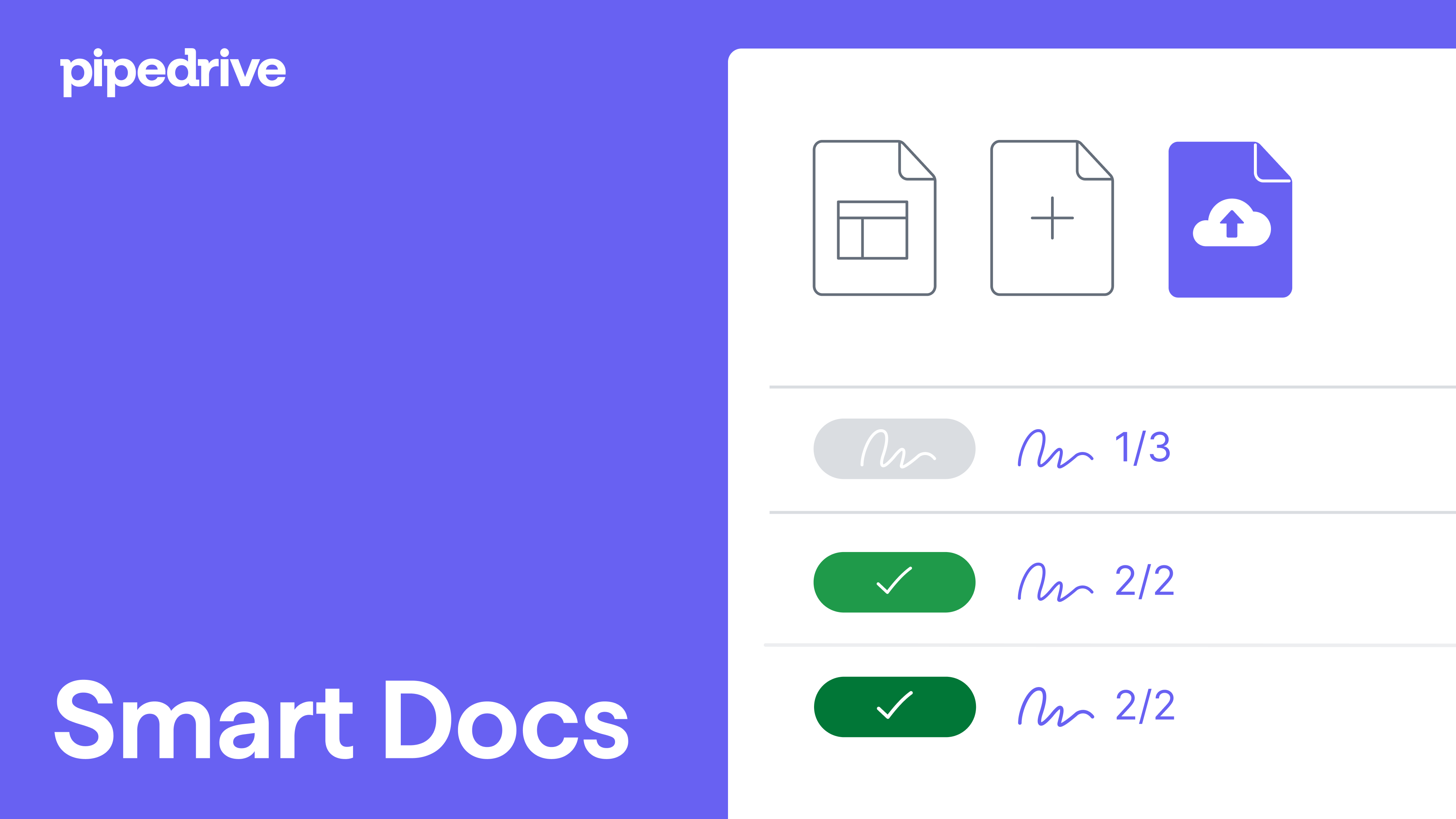
Conexión a tu proveedor de almacenamiento
Para conectar Smart Docs, ve a la página de detalles de un trato o contacto, haz clic en la pestaña "Documentos" y selecciona "Conectar almacenamiento en la nube". Puedes conectarte mediante tres proveedores: Google Drive, OneDrive de Microsoft o SharePoint.

Se te guiará a través de un proceso para otorgarle permiso a Pipedrive para acceder a tu cuenta. Una vez que te hayas conectado, puedes subir documentos o plantillas existentes guardados en tus tratos, que también se guardarán automáticamente en tu unidad.
Después de conectar tu cuenta, verás la opción de conectar una unidad personal o compartida como tu ubicación de almacenamiento.
También puedes agregar y desconectar tu cuenta en Herramientas y aplicaciones > Documentos y hacer clic en “+ Añadir una nueva cuenta” o “Desconectar”. Puedes obtener más información sobre cómo se almacenan los archivos en este artículo.
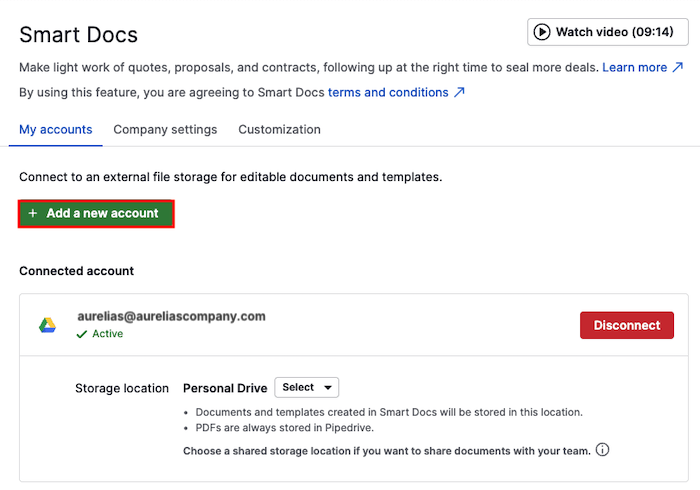
También puedes configurar una memoria compartida predeterminada en tu cuenta.
Crear una carpeta de unidad compartida
Al conectar al proveedor de almacenamiento a la función Smart Docs, verás un menú desplegable en donde puedes seleccionar la unidad de una persona. Al conectar la función Smart Docs, se te asigna automáticamente una carpeta de unidad compartida personalizada. Sin embargo, también puedes crear la tuya propia.

Navega a la pestaña Unidades compartidas en tu cuenta de Google Drive y crea una nueva carpeta:

Una vez creada tu nueva carpeta compartida en Google Drive, ve a Herramientas y aplicaciones > Documentos y selecciona la nueva carpeta compartida para usarla con Smart Docs:
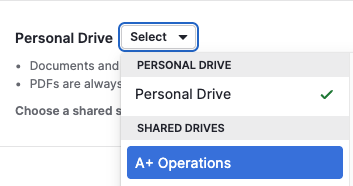
Si la opción para ver o crear una nueva carpeta compartida no aparece en tu cuenta de Google Workspace, puede deberse a la edición que utilizas. Para usar carpetas compartidas, debes tener un plan superior al Business Starter.
Si la cuenta de Google Workspace sincronizada no admite carpetas compartidas, la opción en Pipedrive aparecerá inhabilitada.
Cómo crear y compartir plantillas
Una vez que hayas conectado tu cuenta, podrás empezar a crear documentos y propuestas. Aunque puedes crear un documento directamente, te recomendamos crear primero una plantilla para ahorrar tiempo en futuros documentos.
Para crear una plantilla desde cero, ve a la pestaña Documentos > Plantillas en la vista de detalles de un trato o contacto y haz clic en "Documento", "Hoja de cálculo" o "Presentación". También puedes importar una plantilla de tu proveedor si ya tienes una guardada.
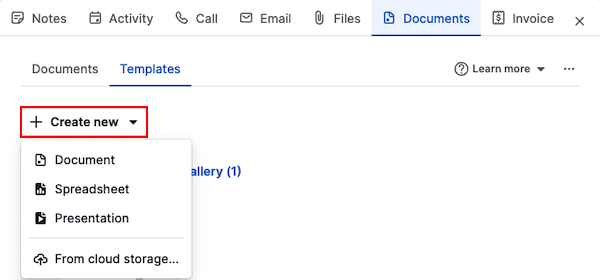
Editar la plantilla
En el editor de plantillas, puedes actualizar el nombre y la categoría de la plantilla, así como agregar cualquier campo de trato, contacto, producto, proyecto o basado en tiempo de Pipedrive para completar el contenido de la plantilla.
Para agregar campos de Pipedrive a tu plantilla, copia y pega el campo desde el lado derecho del editor de plantillas en el cuerpo de la plantilla. El campo aparecerá entre corchetes "[ ]" y se reemplazará automáticamente con los datos del campo cuando se utilice la plantilla en un documento.
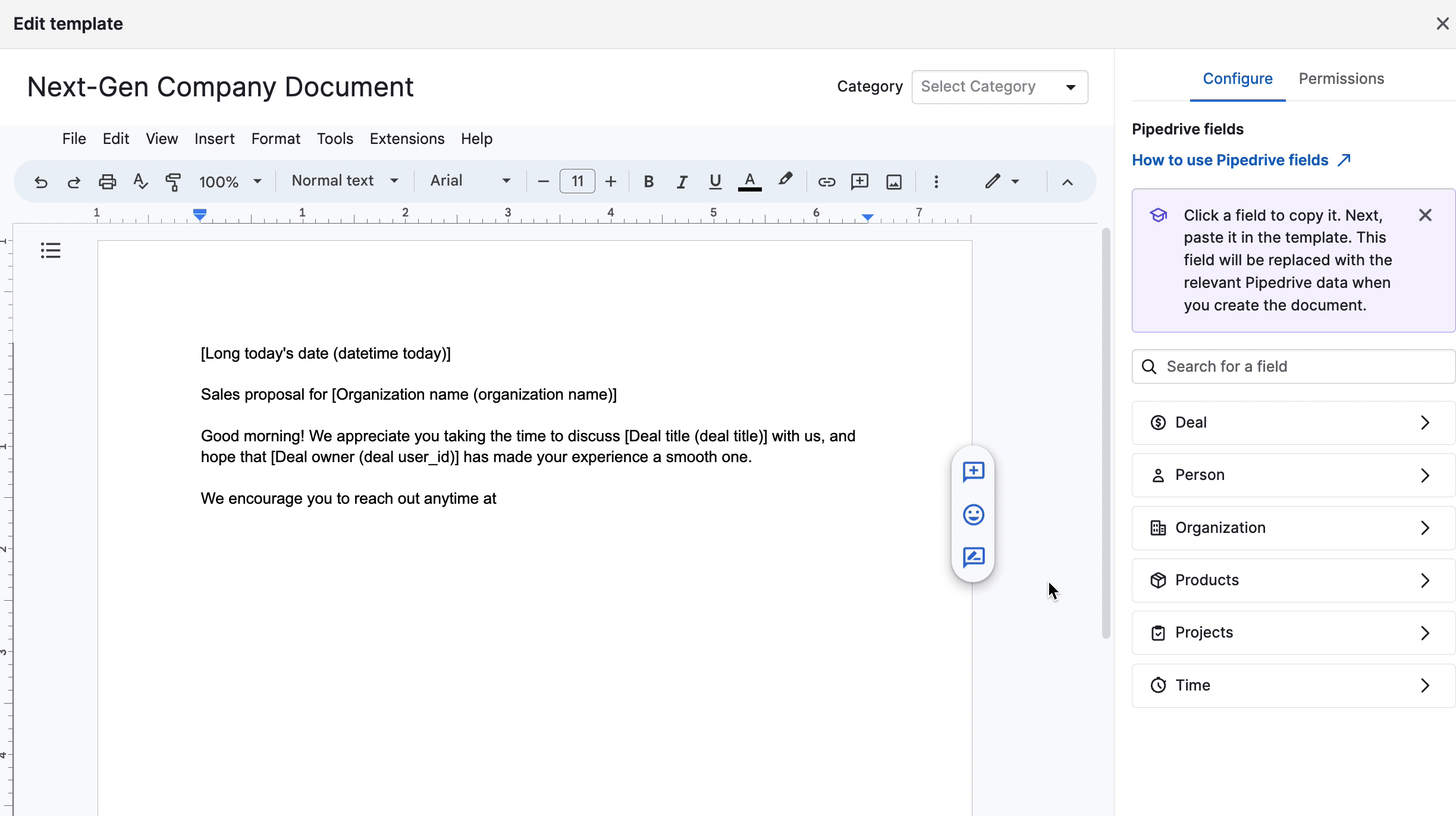
Una vez que hayas terminado de editar tu plantilla, haz clic en “Cerrar” para guardarla o en “Usar para crear el documento” para usarla inmediatamente y crear un documento.
Obtén más información sobre los campos y las plantillas en Smart Docs en este artículo.
¿Cómo puedo compartir plantillas con mi equipo?
Puedes usar la función de uso compartido avanzado de plantillas para compartirlas automáticamente con otros usuarios de Pipedrive. Para compartir una plantilla, ábrela para editarla y haz clic en la pestaña “Permisos”. Hay dos niveles de permisos que puedes otorgar a los usuarios:
- Puedes usar esta plantilla:Ver la plantilla y usarla para crear nuevos documentos; no se puede editar ni eliminar la plantilla original.
-
Puedes editar esta plantilla: Ver, usar, editar y eliminar la plantilla original.

Una vez que una plantilla se haya compartido con otro usuario, aparecerá en la sección "Compartido conmigo" de la galería de plantillas.
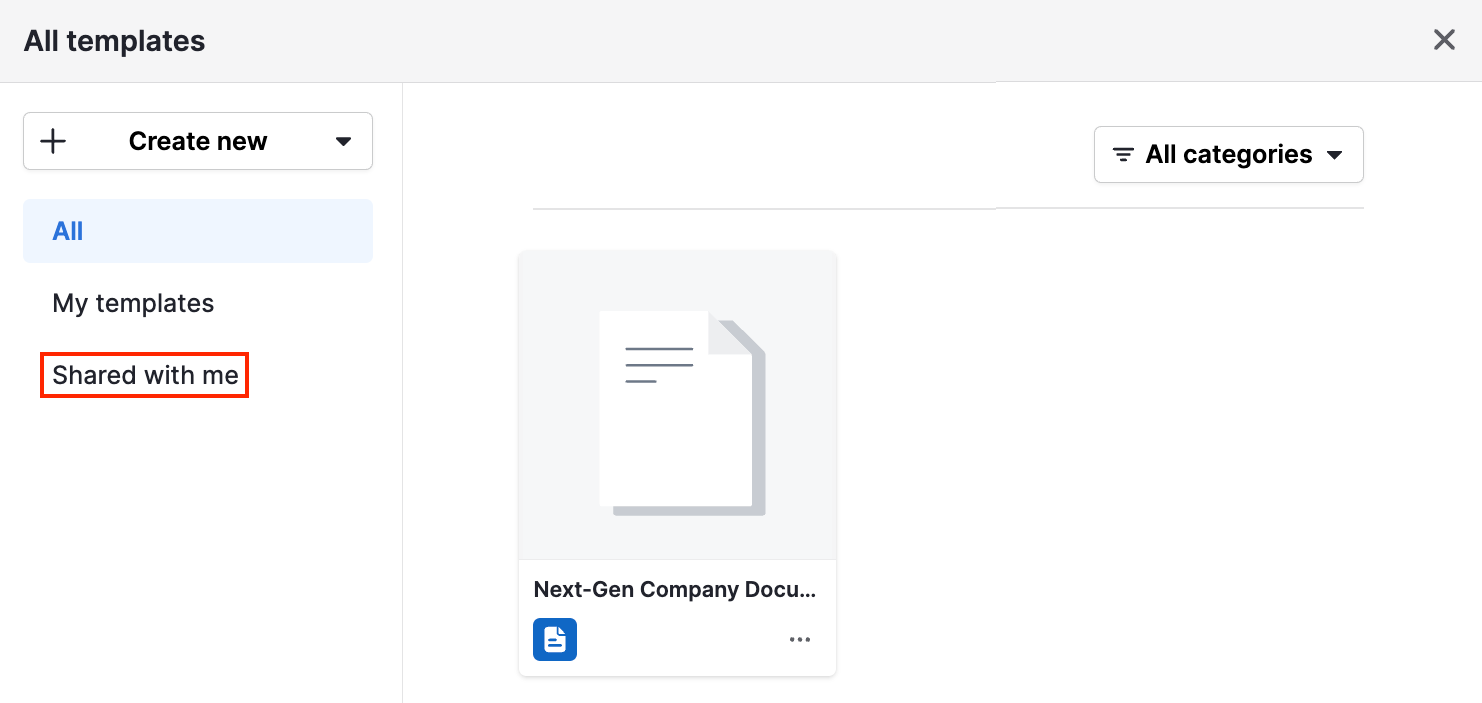
Creación de un documento
Para crear un documento, haz clic en la pestaña Documentos en la vista de detalles de un trato o contacto. Verás la opción de crear un documento a partir de una plantilla previamente creada o crear uno desde cero con un documento en blanco, una hoja de cálculo o una presentación.
También puedes importar documentos predefinidos desde tu dispositivo o una cuenta conectada con Google Drive, Microsoft OneDrive o SharePoint. Los documentos guardados localmente también se pueden cargar como PDF desde tu dispositivo.
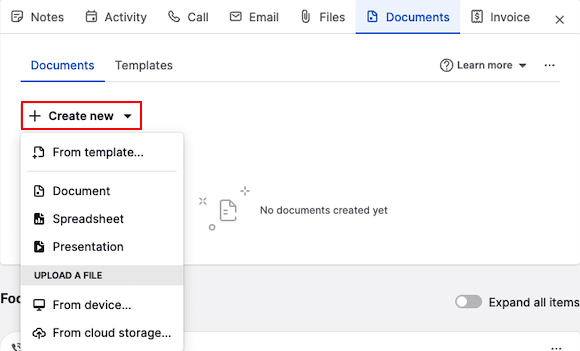
Para crear un documento a partir de una plantilla existente, haz clic en “Desde plantilla” y selecciona la plantilla que deseas utilizar. El editor de documentos aparecerá con todos los campos de la plantilla rellenados con los datos correspondientes.
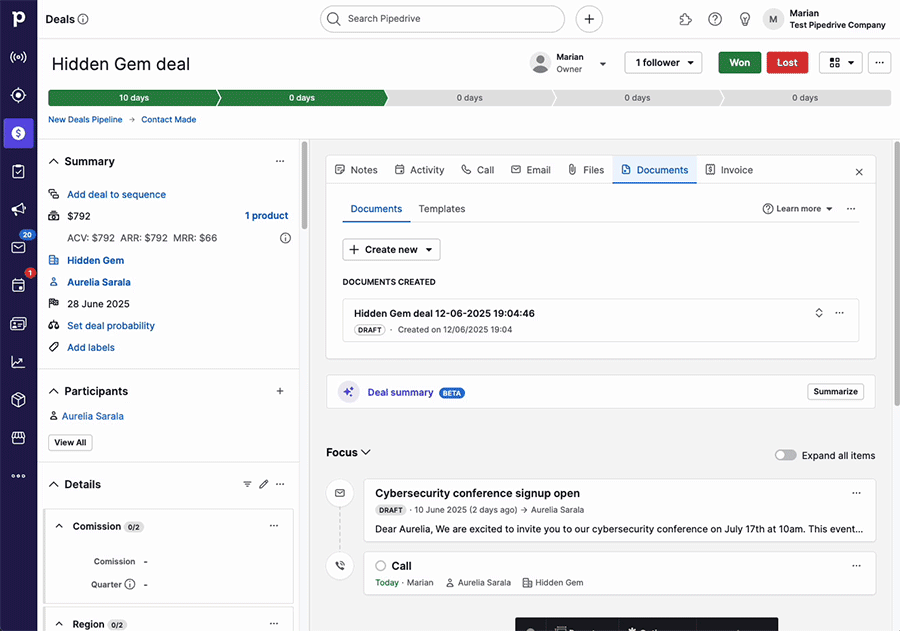
Puedes personalizar el nombre y la categoría, y ajustar el contenido según tus preferencias. El documento se guardará automáticamente mientras trabajas.
Para crear un documento con marcadores de posición específicos del trato, debes crearlo desde la vista de detalles del trato. Para crear un documento con marcadores de posición específicos de la persona, debes crearlo desde la vista de detalles del trato o persona.
Para visualizar y compartir tu documento
Google Drive: Si haces clic en el botón "Compartir" en la esquina inferior derecha del editor de documentos, puedes compartir el documento, descargarlo como PDF o eliminarlo.
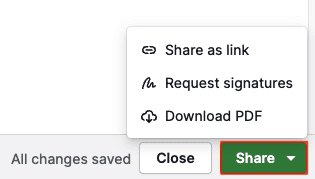
- Compartir como enlace: Genera un enlace a una versión PDF de solo lectura de este documento, que se mostrará en una ventana del navegador una vez que el destinatario lo abra.
- Solicitar firmas: Solicítale firmas a los destinatarios de los documentos.
- Descargar PDF: guarda el documento localmente para que lo puedas adjuntar al correo electrónico o enviarlo directamente a tus clientes.
OneDrive y SharePoint: Para compartir tu documento, primero deberás cerrar el editor de documentos y hacer clic en el botón “...” en el documento creado en la página de detalles.
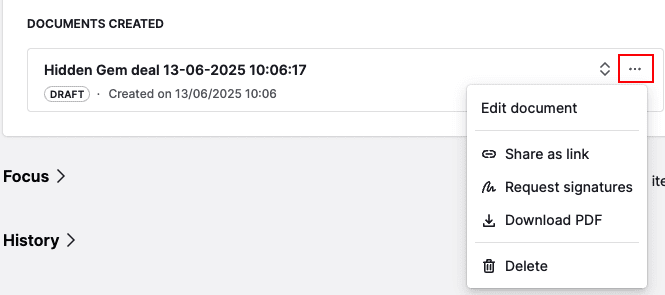
Al compartir tu documento con un enlace, tendrás la opción de rastrear las vistas y configurar las notificaciones por correo electrónico cuando alguien abra el documento.
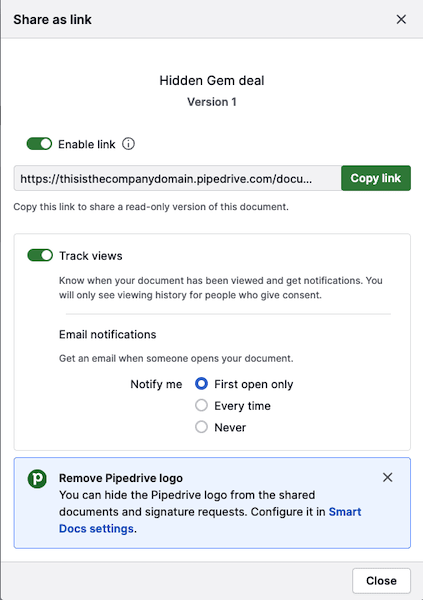
Si activas la opción de rastrear las vistas, podrás recibir notificaciones por correo electrónico cuando tu documento se abra por primera vez, siempre o nunca.

Una vez generado el enlace, lo verás guardado como una versión dentro del documento original, con el número de vistas y la fecha de creación, y ya no podrás actualizar esa versión.
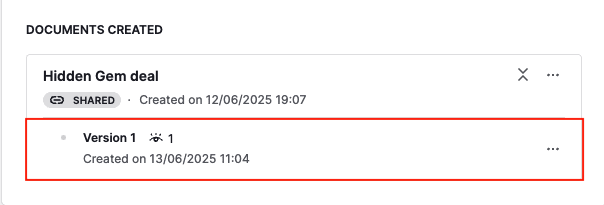
Para crear otra versión de un documento, haz clic en el documento original, realiza las actualizaciones necesarias y genera un nuevo enlace. Una vez generado el enlace, lo verás como Versión 2 dentro de tu documento:
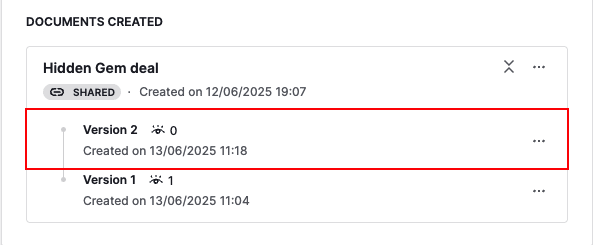
Si creas otra versión de un documento, te recomendamos deshabilitar el enlace de la primera versión para que no haya dos versiones activas. Para ello, haz clic en el icono "..." de la primera versión y haz clic en Compartir como enlace > Habilitar enlace para deshabilitarlo.
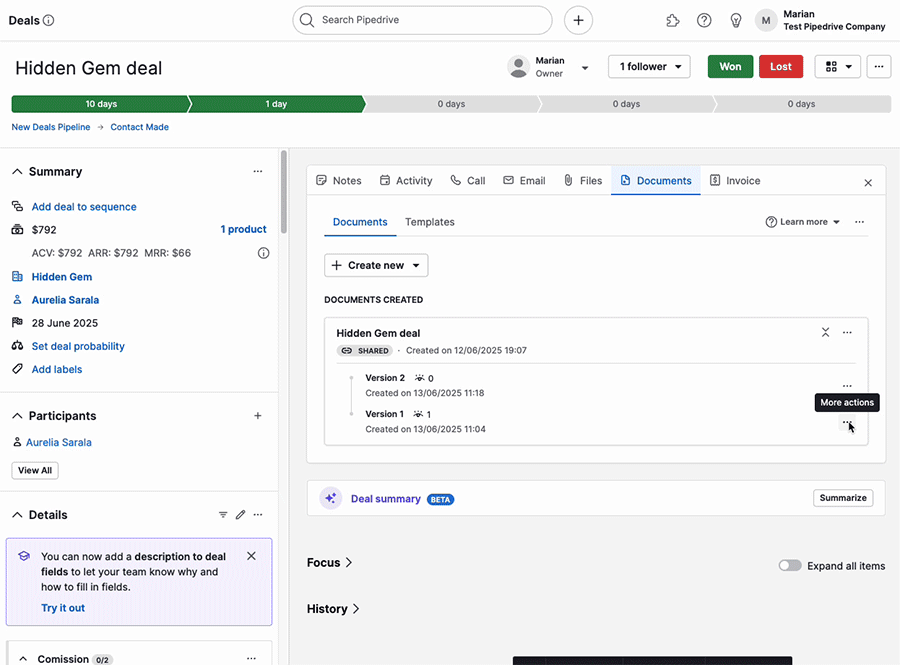
Para añadir una firma a tu documento
Smart Docs también incluye la función de firmas electrónicas, para que puedas solicitarles a tus clientes sus firmas sin necesidad de herramientas adicionales.
Crea o carga un documento con la función Smart Docs desde la página de trato o contacto y busca la opción para solicitar firmas. Aprende a solicitar firmas para tus documentos en este artículo.
¿Te pareció útil este artículo?
Sí
No